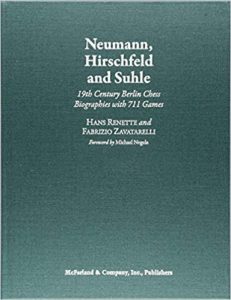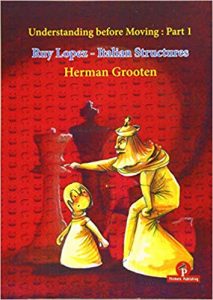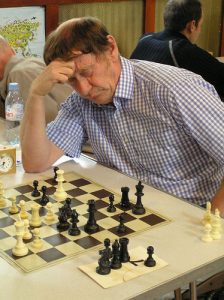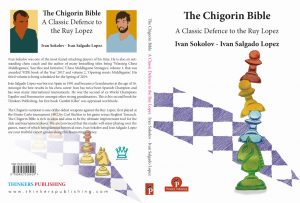
The BCN office has received a copy of “Chess Tactics : Volume 1” by FM Carsten Hansen for review.
Watch this space !



Neumann, Hirschfeld and Suhle : 19th Century Berlin Chess Biographies with 711 Games : Hans Renette & Fabrizio Zavatarelli
Hans Renette

Neumann, Hirschfeld & Suhle. Sounds like a Berlin law firm, doesn’t it? In fact they were 19th century Prussian born chess players with Berlin connections, all active in the 1860s. You tell me you’ve never heard of them? One of them may well be the strongest (for his time) player you’ve never heard of.
Let me take you back to the year 1860. Morphy’s short career in competitive chess had already come to an end, and Steinitz (strange to think he was a year older than Morphy) was just a fairly promising youngster. Anderssen was still active, along with younger players such as Kolisch and Paulsen, but, if you remove Morphy from the equation, there was no clear number one player.
Among those just below the top was (Carl Friedrich) Berthold Suhle (1837-1904), the first of this book’s joint protagonists. Suhle had a very brief chess career spanning the late 1850s up to 1865, when he returned home from Berlin, choosing to focus instead on family life and his career as an academic specialising in Ancient Greek.
Enter Philipp Martin Hirschfeld (1840-96), who, when he arrived in Berlin in 1859, already had a reputation as a theoretician. He was as yet no match for Suhle, though: in a nine game match in 1860 he could only muster two draws. (Note that Jeff Sonas, on his Chessmetrics site, mistakenly dates this match to 1865, causing him to overstate both Hirschfeld’s rating in the early 1860s and Suhle’s rating in the late 1860s.) Like Suhle, Hirschfeld decided to concentrate on his career rather than become a chess professional. Joining his father’s business, he set up a tea company, travelled widely and lived in London through much of the 1870s and 80s. He maintained his interest in chess for the rest of his life but never took part in international tournaments.
The main part of the book is devoted to Gustav Richard Ludwig Neumann (1838-81), who, for a few years round about 1870 was one of the best three or four players in the world. Neumann was a real chess addict who decided to make a living through his favourite game. His first international tournament was Paris 1867, where he finished 4th behind Kolisch, Winawer and Steinitz. Later the same year he won a small but strong tournament in Dundee, this time ahead of Steinitz. It seemed like a new star had arrived, but at the end of 1869 he suffered a mental breakdown and was taken to an asylum. He recovered well enough to be released the following April and that summer resumed his tournament career at Baden-Baden, where he finished 3rd behind Anderssen and Steinitz, and level with Blackburne. Sadly, his mental illness returned at the end of 1872, putting an end to his chess career. Neumann was one of the great might-have-beens of chess, but you’ve probably never heard of him.
The two authors of this volume are both respected chess historians who have written other biographies for McFarland. Hans Renette has penned excellent books on Henry Bird and Louis Paulsen, while Fabrizio Zavatarelli has published a book on Ignaz Kolisch. In 2015 they discovered that Hans was researching Neumann while Fabrizio was studying Suhle and Hirschfeld. Given the overlap in time and place they decided it would make sense to pool their resources.
If you’re familiar with McFarland biographies you’ll know what to expect and won’t be disappointed. A sturdy, large format hardback which will sit impressively on your bookshelf, 711 games with annotations taken from contemporary sources and computer-aided updates from the authors, many atmospheric photographs and outstanding historical research, The English is not always entirely idiomatic, but no matter.
Although the book probably won’t do much to improve your rating, lovers of attacking chess will be delighted to see a lot of Evans Gambit and King’s Gambit games, with the Ruy Lopez in third place. By today’s standards these players were not so strong, but all of us, from Magnus Carlsen down to the humblest patzer, are standing on the shoulders of giants. If you value the history and heritage of our wonderful game you’ll want to find out more about Suhle, Hirschfeld and Neumann, all of whom part of what makes us what we are.
Here’s a crazily complicated game from the book. You’ll have hours of fun spotting the missed opportunities for both players.
Richard James, Twickenham June 7 2019

Book Details :
Official web site of McFarland Books


Cyrus Lakdawala is an IM and former US Open Champion who teaches chess and has written over 25 books on chess openings.

This book is a comprehensive review of all the main continuations after White has played d4 and c4 as his first two moves. It covers the Nimzo-Indian Defence, King’s Indian Defence, Benko Gambit, Grunfeld Defence , Slav Defence , Semi-Slav Defence and so on. The book is highly instructive and contains detailed reviews of 72 games including many modern examples from Carlsen, Kramnik and Mamedyarov as well as classics from the likes of Kasparov and Korchnoi. It also includes a handful of the author’s games.
A notable feature of the book is the author’s writing style which is often effusive, sardonic and humorous. The purists may find this annoying but I quite enjoyed it. Take this example from the Introduction as he explains why he switched to d4, c4. ‘… my openings lacked arable land in which to be creative. For decades my choices had been kissing simplicity’s butt, in a naked display of sycophancy, not seen in the world since Henry VIII’s wives.’
The book is clear and easy to read. Despite its 448 pages, some of the lines are not covered in great depth. The Dutch Defence gets four illustrative games and just 18 pages. So there is probably not enough detail for the GM preparing for his or her next tournament. However if you are a club player this book is an invaluable and enjoyable resource which will definitely improve your handling of all Black’s main responses to this opening.
Paul Sloane, Camberley, Surrey, May 30th, 2019

Book Details :
Official web site of Everyman Chess



BCN is delighted to have received recent publications from McFarland Books. They are :
British Chess Literature to 1914 : A Handbook for Historians by Tim Harding

and
Tal, Petrosian, Spassky and Korchnoi : A Chess Multibiography with 207 Games by Andrew Soltis


FM Matthew Wadsworth, one of England’s most promising young players, has earned his first Grandmaster norm from his excellent performance in the Four Nations Chess League (4NCL). Matthew, who is eighteen (nineteen in June), has a current FIDE standard play rating of 2413 and is ranked 34th amongst the active players in England (by FIDE rating) earning his FM title in 2016. Matthew has IMs norm under his belt but could leapfrog to Grandmaster status with further norms and by increasing his live rating to 2500. Most likely, however, is that the IM title will be ratified at the next FIDE Congress now that his live rating has topped 2400.
Matthew’s first ECF grade was 66A in 2007 (aged 7) and he played for Maidenhead in local leagues, St. Pirans’s School and then Reading School. Matthew joined 4NCL at an early age and played for AMCA (Andrew Martin Chess Academy) soon rising the ranks to the AMCA first team and he currently represents the Guildford 2 team in Division One of the Four Nations Chess League (4NCL). Matthew’s 4NCL results for the 2018-19 season were :
1. Fodor, Tamas Jr, draw
2. Ashton, Adam G, win
3. Gonda, Laszlo, draw
4. Kulon, Klaudia, win
5. Holland, James P, win
6. Stewart, Ashley, win
7. Ledger, Andrew J, win
8. Plat, Vojtech, loss
9. no game
10. Jackson, James P, win
11. no game
giving a performance of 7/9
One of the undoubted highlights of Matthews chess year was has draw with Oxford domiciled GM Hou Yifan, three times Women’s World Champion from China during the annual Varsity match, Matthew representing Cambridge.


The author of this book Herman Grooten is an International master and has taught players such as Loek van Wely.

At the start of the book Grooten emphasises that many chess players memorise lots of opening theory but it does not improve their results as they do not understand the position when their opponent deviates from theory.
He explores the various pawn structures in variations of openings in the Ruy Lopez (Spanish Game) and (Giuoco Piano) Italian game.
The first variation he looks at is the so-called Berlin wall (Berlin Defence) which was used very successfully by Vladimir Kramnik in his World Championship match vs Gary Kasparov.
Knowing Kasparov was a great attacking player Kramnik chose a variation which leads to a Queenless middle game.
Although Black ends up with doubled pawns on the Queenside (as in the Ruy Lopez, Exchange Variation) his bishop pair is good compensation and his doubled pawns are not weak and easily exploited.
Grooten then shows what each side should be trying to achieve to progress their position.
In the Open Lopez the pawn structure is very different : White has a four to three pawn majority on the kingside and with a pawn on e5 and good use of the d4 he has good chances for an advantage and it is well known that Viktor Korchnoi played the Open Lopez in his famous match with Anatoly Karpov. Black has a four to three majority on the queenside but his c7 pawn is backwards and weak. If Black can play c5 then he will probably equalise but he normally cannot afford to play Nxd4 as after cxd4 his c7 pawn is very weak.
Next Grooten examines variations of the Closed Lopez where play typically goes 5 Be7 6 Re1 b5 7 Bb3 00 8 c3 d6 9 h3. Here the Zaitzev 9…Bb7 Chigorin 9…Na5 and Breyer 9…Nb8 are explored in detail. In all three of these famous lines the pawn structure is the same White pawns on c3 d4 and e4 Black pawns on c5 d6 and e5.
White normally can decide the structure by either playing d5 or d4xc5 or maintain tension with Nbd2 when Black can change the structure with c5xd4,
Paul Keres often did this in the Chigorin Variation.
Grooten looks in depth at the theory of the Two Knights where White plays 4 Ng5 including some variations in the main line 5 Na5 which I have not seen before and maybe are unusual and interesting.
Finally, He also looks at some interesting world class games the best of which is a win by Paul Keres over Mikhail Tal as Black in the Chigorin Variation.
In summary, this excellent book will appeal to club players who know these openings but are not sure what plan(s) to adopt in the consequent middle game.
Colin Lyne, Farnborough, Hampshire, May 1st, 2019

Book Details :
Official web site of Thinkers Publishing


Gata Kamsky was born in 1974 in Siberia. When moved to Leningrad he became a student of the renowned veteran trainer, who had coached since about 1945, witness Spassky and Korchnoi ! and author (‘Improve Your Chess Results’ and ‘The King’s Gambit’ with Viktor K), Vladimir Zak. At 12 he won the USSR Junior Championship. However, early journeys into the top game were not always successful and his fast track was criticised even by Botvinnik himself.

His father brought Gata up alone and loomed large in the prodigy’s life, Kamsky Senior even stopping Short in his tracks (“Where is your father?”). He was moved to the USA in 1989 but, sadly, has recently stated that he was never fully accepted. He became GM shortly afterwards.

Although a 1996 FIDE World Championship challenger, he lost a well contested match versus Karpov, whereupon Kamsky Senior announced Gata intention to pursue a career in medicine. He had withdrawn from the game, was seeking a teenage bride, and by order!
This book deals with the first part of an incredible career up to 1996. It centres on 22 games, all against fellow grandmasters, all with very deep notes. The text lacks an index. No attempt is made to list his tournament record, or give family photos or reminiscence. It is the first of two volumes, the second yet to appear.

A recent interview on ‘Perpetual Chess Podcast’ saw Gata labeling himself an advocate of the Lasker School. He emerges from an era when preparation might even be considered cheating. a big fan of endgame studies. Further, he is revealed as almost humble, of great depth who, the introduction to his book states, as author, seems to want to be compared with Fischer. I don’t agree but, BCN, as ever, welcomes correspondence here.

Potential buyers of this book, which is subtitled ‘Awakening’ should definitely listen in to his interview and please let us know what you think.

James Pratt, Basingstoke, April 2019
Book Details:
Official web site of http://www.thinkerspublishing.com


The Chigorin defence to the Ruy Lopez comes about when black plays the closed 5…Be7 variation and play continues 6.Re1 b5 7.Bb3 d6 8.c3 00 9.h3 now black unleashes 9…Na5.
The opening is named after the Russian player Mikhail Ivanovich Chigorin (1850 to 1908) who twice played Wilhelm Steinitz for the world title, losing on both occasions.
The authors of the book are Dutch Grandmaster Ivan Sokolov and Spanish (appropriately enough !) Grandmaster Ivan Salgado Lopez.


Anyone playing the black side of 1.e4 e5 2.Nf3 Nc6 has to face the problem of how to get equality after 3.Bb5 undoubtedly the most challenging move. White’s normal strategy will often be to play for a kingside attack and therefore black needs to find a good defence that gives him equal chances and the opportunity to take over the initiative if white goes astray. The two Ivans offer a defence to the Ruy Lopez that seems to do that and one which is a lot more interesting than the (in my opinion) boring (according to many!) Berlin Defence.
Firstly, I was surprised to learn that this opening variation was first played by (1910 World Championship Challenger) Carl Schlechter in 1902 and his opponent was Dr. Siegbert Tarrasch. Chigorin himself played the defence twice but it was Akiba Rubinstein who made the opening popular playing it many times against world class opponents. Later on Capablanca, Lasker, Botvinnik, Euwe, Reshevsky and particularly Paul Keres all helped to make it a popular response to the Spanish Opening.
The book starts out by discussing early games and detailing middle game plans for Black. The first variation to be discussed in detail is 10.Bc2 c5 11.d4 Qc7 12.Nbd2 citing the stem game Lasker vs Tarrasch giving an excellent example of how black should play the position. A whole chapter then looks at the games of Paul Keres (most of which he won) however it does not include his famous game v Robert James Fischer (Zurich 1959) which is nevertheless analysed in another chapter : Fischer won that historic encounter.
An attractive (and unusual ) feature of this book is that it also points out best lines for White to play rather than simply evangelizing the Chigorin Variation from Black’s perspective. An example of this is when black chooses 11…Bb7 over 11…Qc7 and after 12.d5! it is difficult for black to activate the bishop or the knight on a5.
A better 11th move for Black is Nd7 which features in several games. Here again the author’s point out that 12.d5 is playing into blacks’ hand as he plays Nb6 intending f5. A better try is 12.a4 as a number of high level games demonstrate.
The latter part of the book discusses much theory and sums up which lines are promising for each player and which are to be avoided.
Summing up, I would say that this is an excellent book and any player studying it is likely to be better prepared than their opponent for sure.
Colin Lyne, Farnborough, Hampshire, April 16th, 2019

Book Details :
Official web site of Thinkers Publishing
